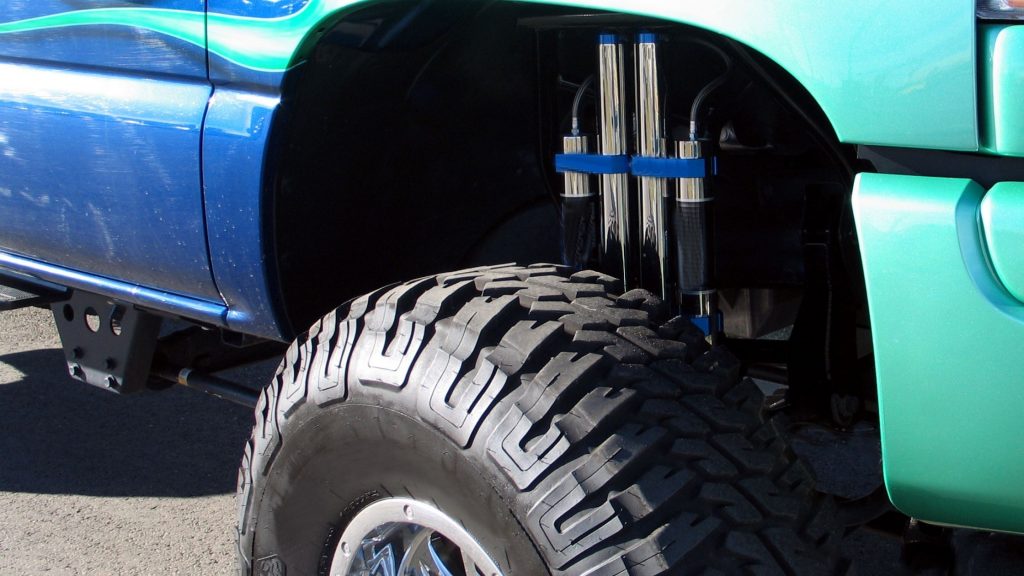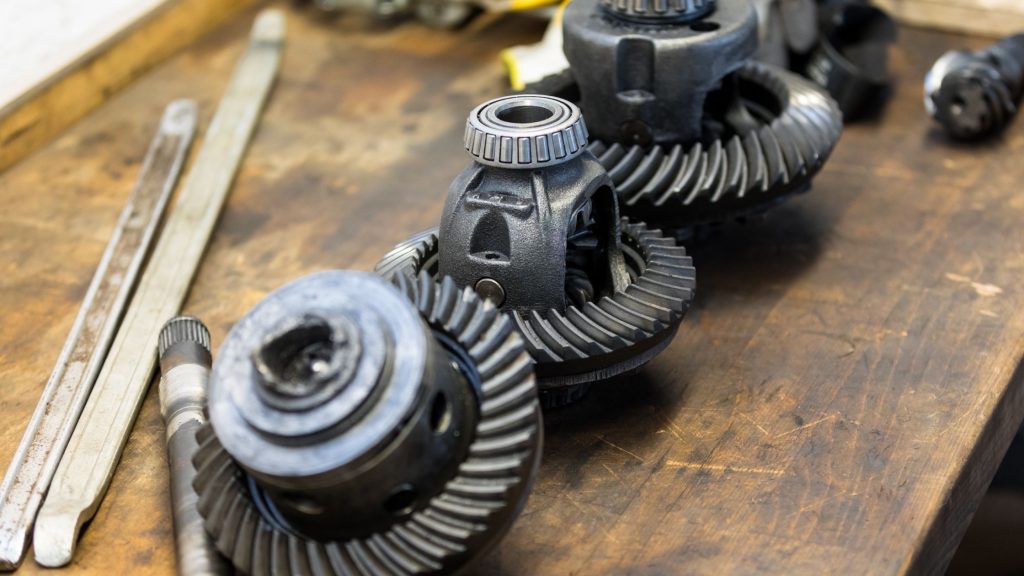You’re driving down the highway and you pass a lifted truck sitting on some beastly looking all-terrain tires. It’s decked out with all the fancy fittings of an expensive off-road rig, and without a doubt you’re assuming that baby is rocking a four wheel drive.
What if it wasn’t?
I’ve had my fair share of friends rolling up in two wheel drive Ford Rangers that they’ve fitted with a 3” lift kit. While lift kits are pretty commonplace in the off-road community, why go through all the effort and expense of putting a lift on a truck not fully capable of “proper” off-roading?
I’ve heard a lot of off-roaders scoff at the idea of lifting a 2WD truck. Some believe it’s a waste of time and money. That’s not really the case! There are actually many reasons to lift a truck with only two-wheel drive, and I’m going to give you the full scoop on why you just might want to consider it.
Can You Lift a 2WD Truck?
Since I just mentioned above that I’ve seen it done on many different truck, yes, you most certainly can lift a 2WD truck.
For some, owning a 2WD truck is the most accessible option, since 2WD trucks are generally cheaper to own. They’re cheaper on gas, maintenance costs are lower, and when it comes to lift kits, they’re cheaper to install.
When lifting a truck there are two types of lifts to consider:
- Body lift: A body lift will raise the body of your truck away from the frame, while the suspension remains stock.
- Suspension lift: This is the most common style of lift for off-roading. A suspension lift will enhance off-road capability as it will provide the most ground clearance.
When it comes to lifting a 2WD truck with IFS, if lifting more than 2 inches, a suspension lift will be much cheaper and easier to install than on a 4WD vehicle.
The reason lift kits are easier (cheaper) to install on a 2WD is because a 2WD truck only has one differential. This means that during installation only one differential needs to be cut out and lowered, versus two on a 4WD truck.
While there may be more lift kits available for a 4WD truck, there are still loads of lift kits available for a 2WD truck.
The Benefits of Lifting a 2WD Truck
Now that you know it is possible to lift a 2WD truck, let me explain a little more about why you might want to.
I know most people who own a 4WD capable truck will never need to engage the 4WD function. Sure, it sounds great to have the option of that four wheel capability, but it can go to waste if never used.
It can cost big bucks to purchase a decent four-wheel drive truck, and I personally don’t think it’s worth the cost if the truck won’t be used to its full potential.
In a lot of cases, owning a 2WD truck with a lift kit may be more practical than investing tons of money into a truck with 4WD. I’ll explain the full benefits below.
Increased Ground Clearance
This is one of the primary reasons for installing a lift kit on either a 4WD or 2WD truck. When you’re out driving, whether you’re facing a wild parking lot curb or a riverbed full of boulders, increased ground clearance will save you a lot of stress.
If your intention with your truck is to bomb down the occasional pot-hole ridden logging road, then extra ground clearance makes sense, while 4WD is not really necessary. Even light off-roading is possible in a 2WD truck, and an added lift can make things easier.
Extra ground clearance can also do wonders in the snow, so long as you install a proper set of tires.
Space for Larger Tires
Installing a lift kit on your 2WD truck will allow it to be fitted with a larger set of tires. I briefly mentioned body lift kits above, and space for larger tires is the main benefit of installing a body lift. Don’t worry though, if you are interested in suspension lift, it will also allow for larger tires.
Larger tires will add additional height to your truck, and are also stronger, sturdier and will increase traction. Mud, snow, sand, you name it, a good set of all-terrain tires will make life much easier.
All-terrain tires generally run in larger sizes, as they will have thicker sidewalls and more aggressive tread to achieve better traction and durability. This is why a lift kit is a good idea if you want to fit your truck with some decent all-terrain tires.
It Looks Cooler

This can play a huge role in why someone will lift their 2WD truck. Not every truck owner is looking to hit the trails and risk the damage that comes along with an off-road adventure. In this case, a lift kit is simply there to make their baby look more beastly.
As mentioned above, a lift will allow a truck to be fitted with larger tires, which can do a lot for the overall appearance of a truck. I bet half the lifted Ford Raptors I see barreling down the highway will ever see a speck of dirt on their tires, but that’s okay, because they still look cool as hell.
Appearance is a huge factor when it comes to any vehicle, and if you want to lift your truck just for appearance sake, then do it!
Drawbacks of Lifting a 2WD Truck
As is the case with many things in life, lifting a 2WD truck isn’t all fun and games.
There are still a few drawbacks to consider when lifting your truck. You should always do proper research before making any modifications to your vehicle, and the fact you’re reading this means you’re off to a good start.
So, what are the possible downsides of lifting a 2WD truck? Let’s get into it.
Reduced Handling
After installing a lift kit on your truck, you may find that it handles differently, both on the pavement and off. This is because a lift will do exactly what the name implies, and lift your center of gravity. This can lead to reduced handling at higher speeds and in corners. It may take some getting used to, so reducing speed and driving carefully will be key after installing a lift.
Sacrificing Comfort
When choosing a lift kit for your 2WD truck, it’s very important to pick a good quality kit. If you go solely for the cheapest kit, you may find your ride a little bumpier than expected. With a low-quality lift installed, every pot-hole, speed bump and dip in the road will be felt.
Lower MPG
One of the common reasons for purchasing a 2WD over a 4WD truck is the difference in gas mileage. A 2WD truck will offer better gas mileage than it’s four wheeling brother, but this benefit may be lost after installing a lift kit.
With bigger tires and more drag produced from riding higher, your MPG will suffer. This is definitely something to consider if you’re living in an area with high gas prices!
Parts Wear Faster
After lifting your truck, more tension will be applied to parts like ball joints, controlling arms, and drive shafts. These parts will wear much faster than a truck riding on stock suspension, so your maintenance costs will rise. Proper maintenance of your lifted 2WD truck is incredibly important.
Not Ideal for Towing
A lift kit will impact your towing ability. With your suspension riding higher, it will be important to find a ball mount with enough drop to allow your trailer to sit level with your truck. Overall towing capacity may also be affected if your lift kit isn’t properly fitted.
If you have a boat or travel trailer sitting at home, this will be an important area to research prior to installing a lift kit.
Is It Worth Lifting a 2WD Truck?
The answer here will really come down to what your needs are. A lift kit is not exclusive to a four-wheel drive vehicle. If your dream is to own a lifted truck, then your 2WD shouldn’t stop you!
I am a lover of all things off-road, and for me, a truck with 4WD capability makes sense, but for someone not as inclined to rock crawling or trail blazing, a 2WD truck will do the job. Adding a lift to your 2WD will offer multiple benefits and allow you to tackle more terrain and harsher road conditions.
Installing a lift kit will also give your 2WD truck that beastly, sporty aesthetic and if that’s what you want your truck to look like, don’t let anyone stop you. Just be sure to do your research, find a high quality lift kit, and use a trusted mechanic for the install (which might be you).
Live your best life, and drive your best truck. That’s the motto I live by!
- Tips and tricks For Setting Up Camp Like a Pro - September 11, 2023
- The Best Multi-Tools for Overlanding Adventures - August 25, 2023
- Off-Road Navigation Tips for Overlanders - August 13, 2023


